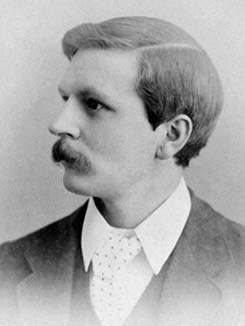


 تاريخ الرياضيات
تاريخ الرياضيات
 الرياضيات في الحضارات المختلفة
الرياضيات في الحضارات المختلفة 
 الرياضيات المتقطعة
الرياضيات المتقطعة
 الجبر
الجبر
 الهندسة
الهندسة 
 المعادلات التفاضلية و التكاملية
المعادلات التفاضلية و التكاملية 
 التحليل
التحليل
 علماء الرياضيات
علماء الرياضيات |
Read More
Date: 21-3-2017
Date: 27-3-2017
Date: 17-3-2017
|
Died: 19 March 1922 in Liverpool, England

George Mathews' father was George Mathews (born at Preston on Wye, Herefordshire about 1815) who was a linen draper. His mother was Harriet Hannah Ballard, daughter of George Ballard, an under secretary at the Inland Revenue. She was born in Shoreditch, Middlesex in 1826. George had two younger siblings, Harriet Hannah and Arthur (twins born about 1866).
George Mathews attended Ludlow Grammar School. From there he went to University College, London where he studied mathematics. He then studied at St John's College, Cambridge from where he graduated as First Wrangler in 1883. The following year Mathews was elected a Fellow of St John's College, and later in 1884 he was appointed to the chair of mathematics at the University College of North Wales at Bangor in the year the university opened.
He taught at the University College of North Wales in Bangor and in Cambridge for periods through his life. He resigned his chair at Bangor in 1896 to return to Cambridge, but in 1911 he resigned from Cambridge and was appointed to a special lectureship at Bangor.
Most of Mathews' research was on number theory but he also wrote texts on Bessel functions and on projective geometry. In his two volume work Theory of numbers (1892) topics covered included Gauss's theory of quadratic forms and their development by mathematicians such as Dirichlet, Eisenstein and Smith. The book also discusses prime numbers and Riemann's memoir on primes but, since it was written two or three years before the prime number theorem was proved, this part of the work became dated rather quickly.
The book A treatise on Bessel functions and their applications to physics (1895) was written by Mathews in collaboration with Andrew Gray who was the professor of physics at Bangor. It was the first major treatise on Bessel functions in English and covered topics such as applications of Bessel functions to electricity, hydrodynamics and diffraction. Here Mathews was luckier than with the number theory work, since even when Watson's treatise on Bessel functions was published in 1922, it did not cover the applications of Mathews's book which continued to be useful and well used.
Mathews also wrote Algebraic equations (1907) which is a clear exposition of Galois theory, and Projective geometry (1914). This latter book develops the subject of projective geometry without using the concept of distance and it bases projective geometry on a minimal set of axioms. The book also treats von Staudt's theory of complex elements as defined by real involutions. The book contains a wealth of information concerning the projective geometry of conics and quadrics.
In addition to his treatises and many papers on the classical theory of numbers, Mathews also wrote some articles for Encyclopaedia Britannica, in particular writing the article on universal algebra and the one on number.
Another role Mathews played in mathematics teaching and administration was as an examiner to the Universities of Ireland and to the University of Manchester. He is described by T A Broadbent in [1] as follows:-
Mathews was an accomplished classical scholar; and besides Latin and Greek he was proficient in Hebrew, Sanskrit and Arabic. He also possessed great musical knowledge and skill. His versatility led a colleague at Bangor to assert that Mathews could equally well fill four or more chairs at the college.
Articles:



|
|
|
|
تفوقت في الاختبار على الجميع.. فاكهة "خارقة" في عالم التغذية
|
|
|
|
|
|
|
أمين عام أوبك: النفط الخام والغاز الطبيعي "هبة من الله"
|
|
|
|
|
|
|
بمساحة تزيد على (4) آلاف م²... قسم المشاريع الهندسية والفنية في العتبة الحسينية يواصل العمل في مشروع مستشفى العراق الدولي للمحاكاة
|
|
|